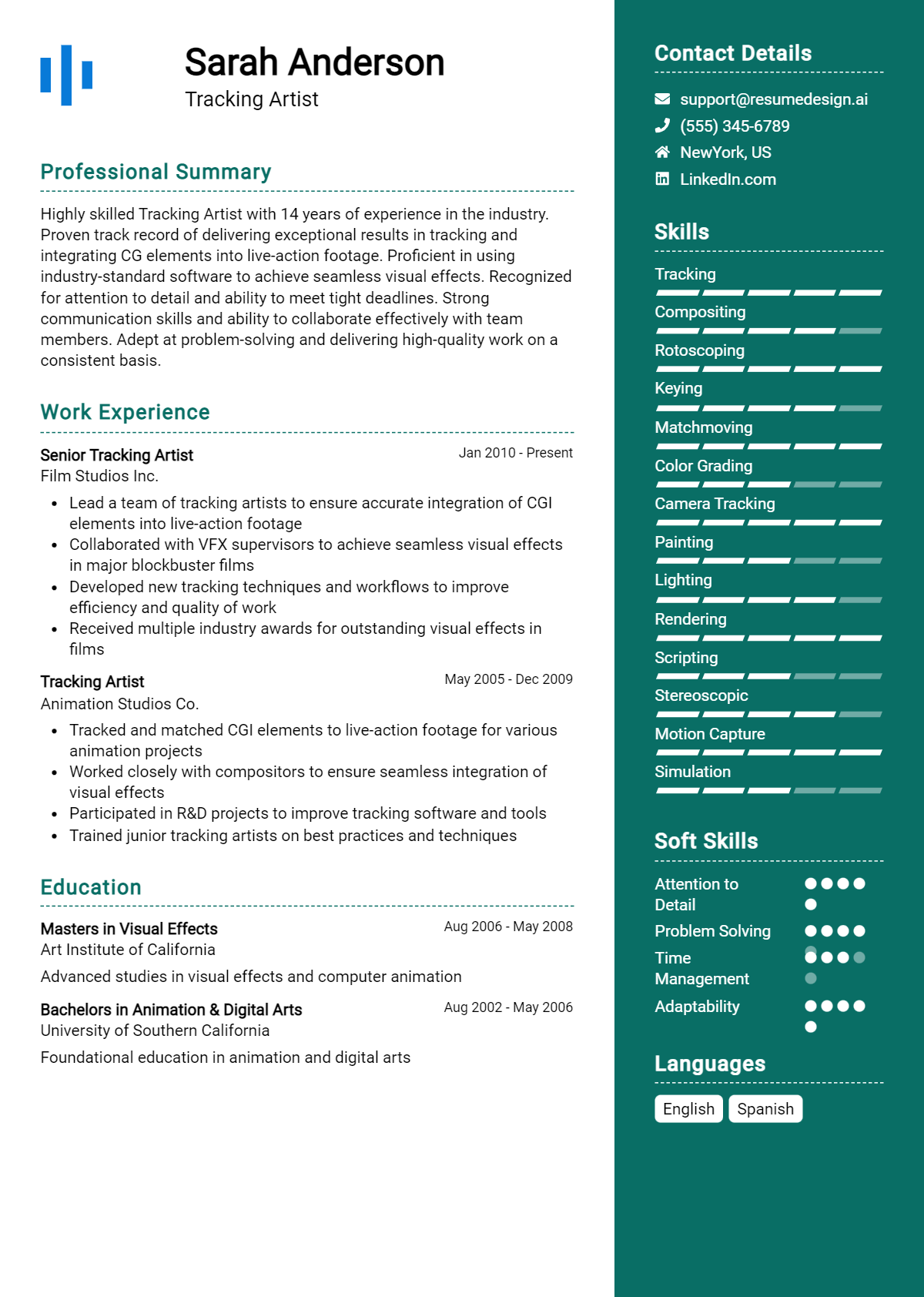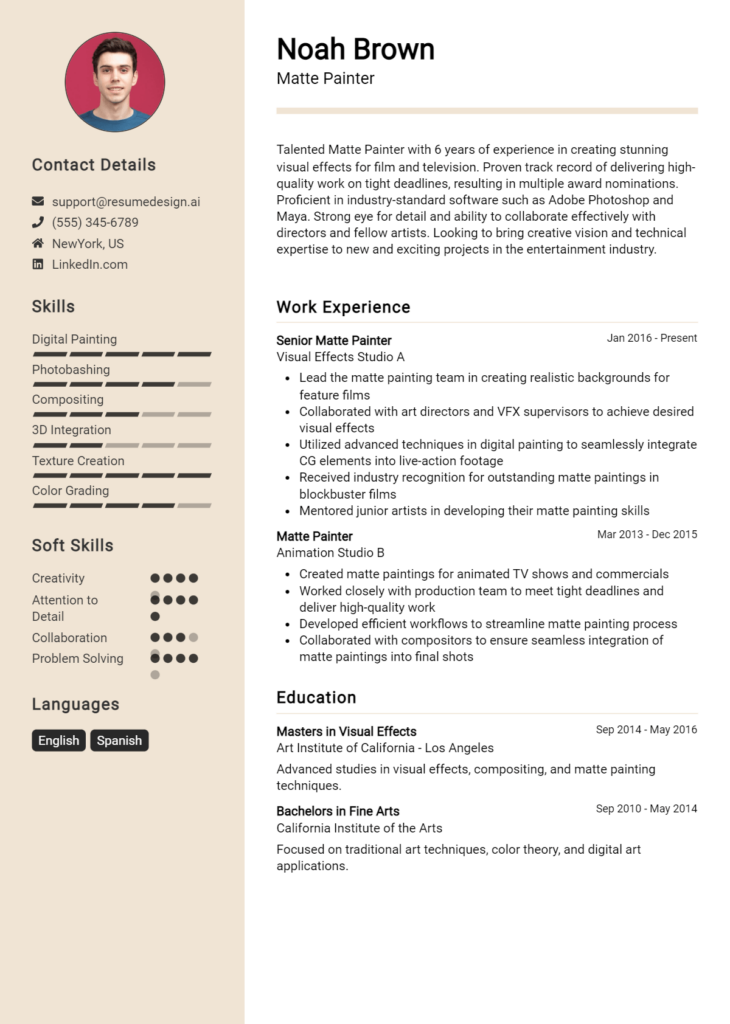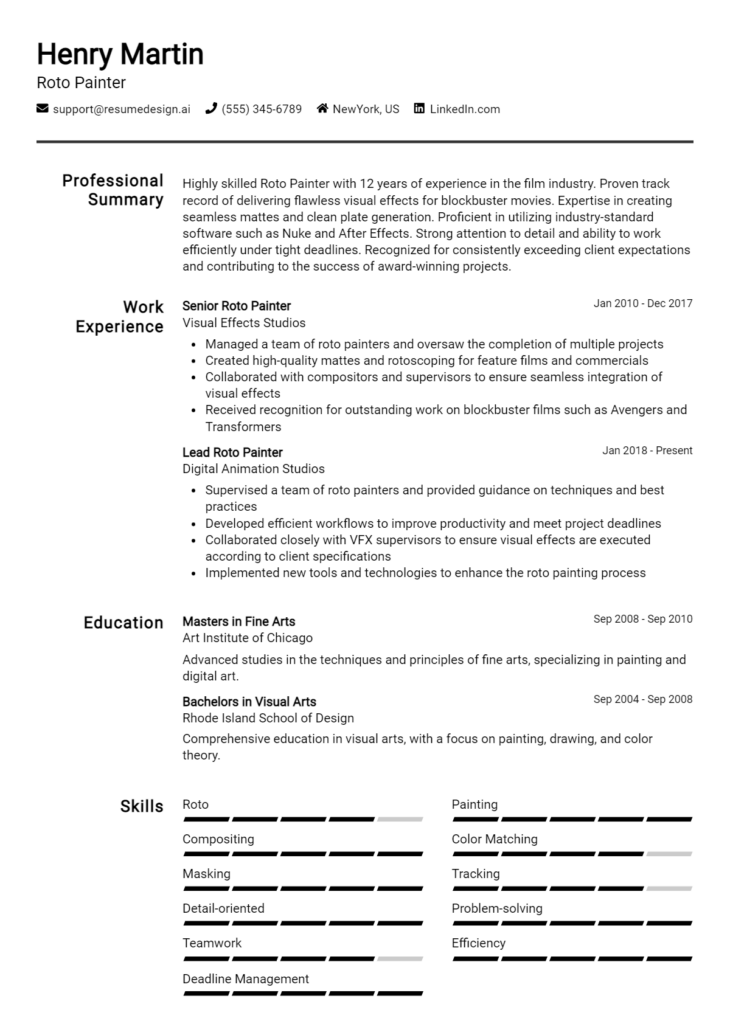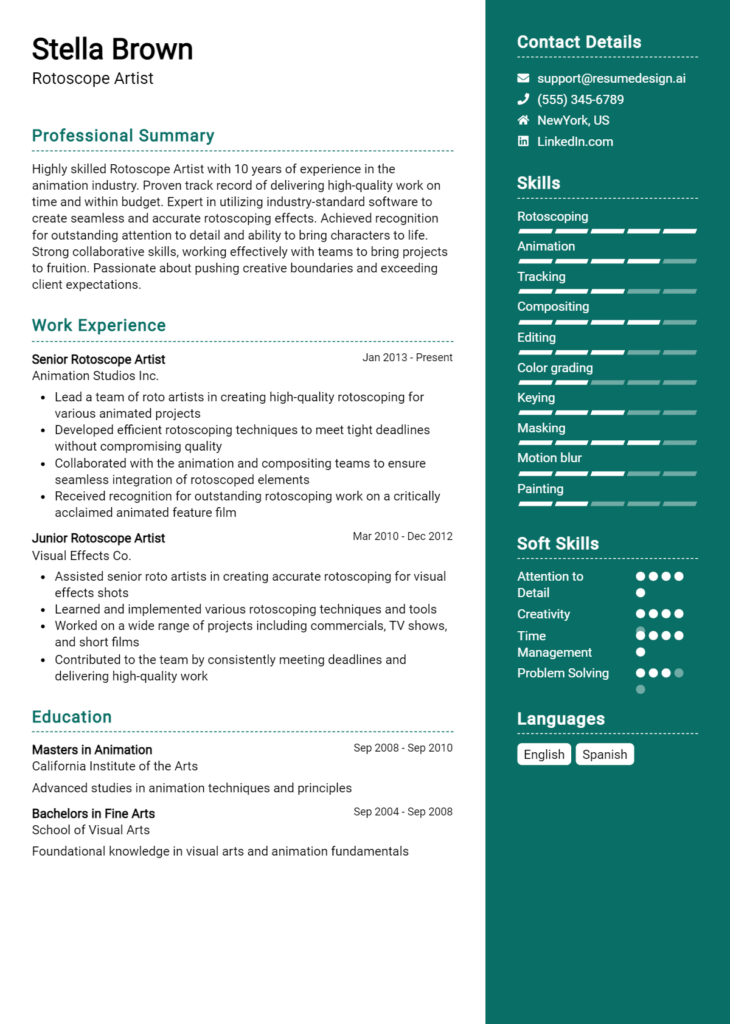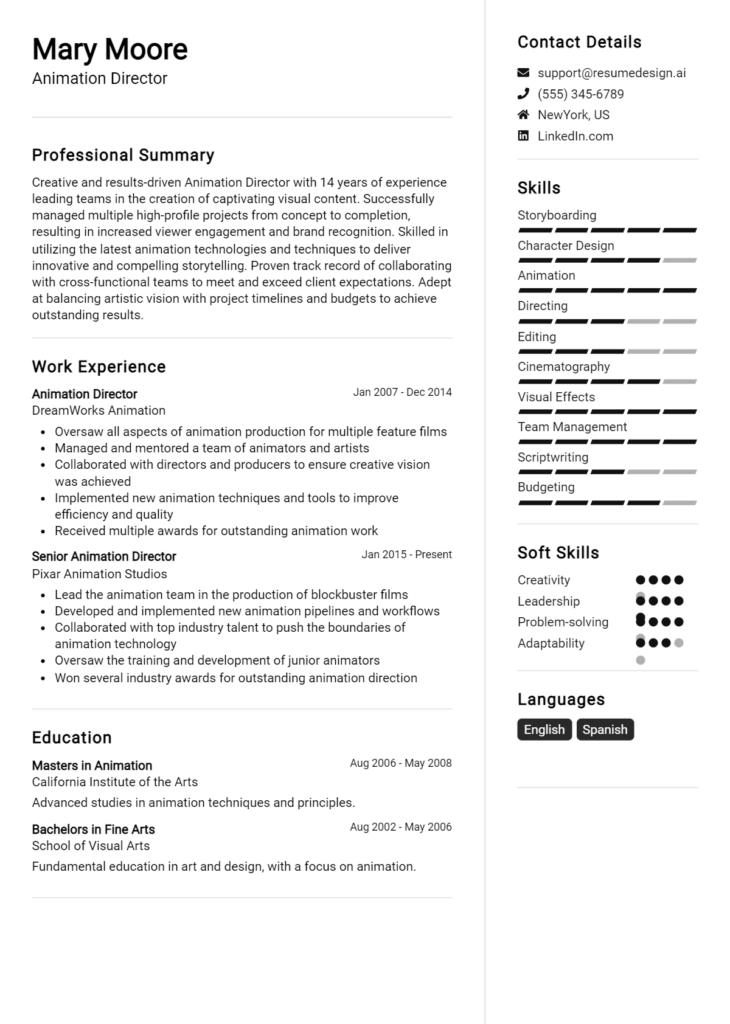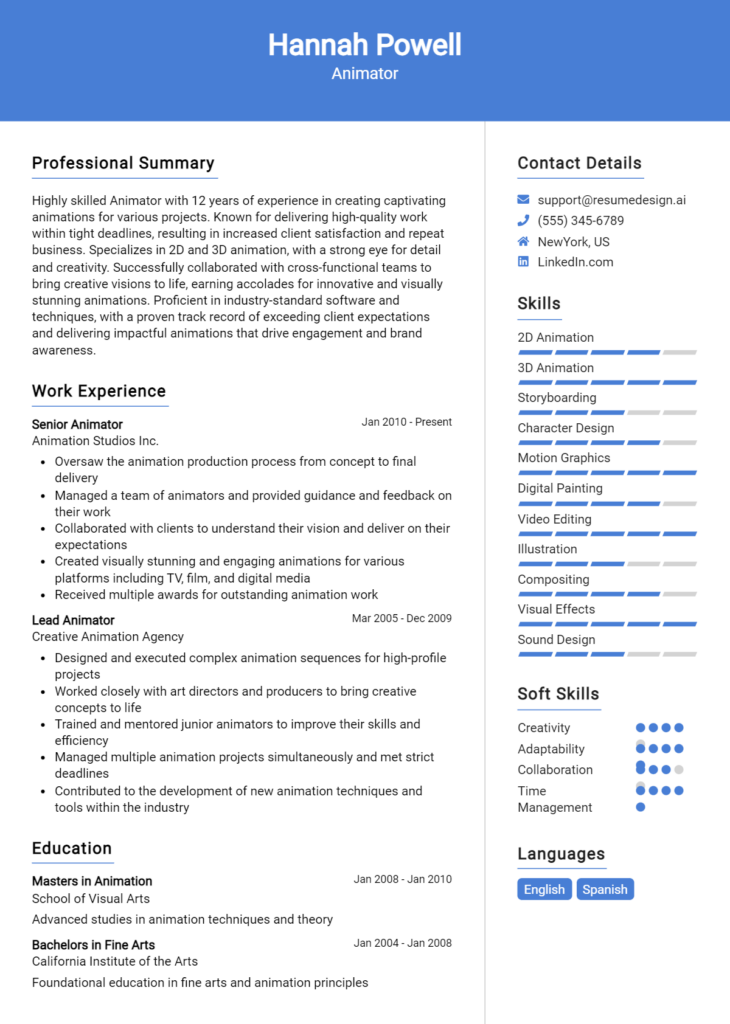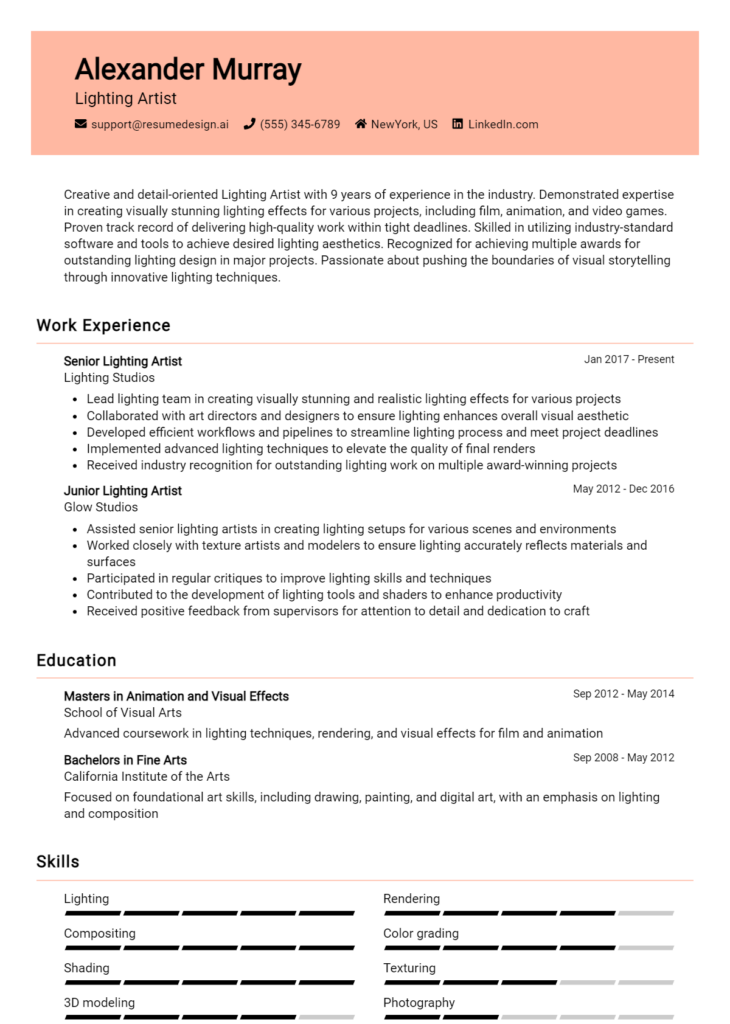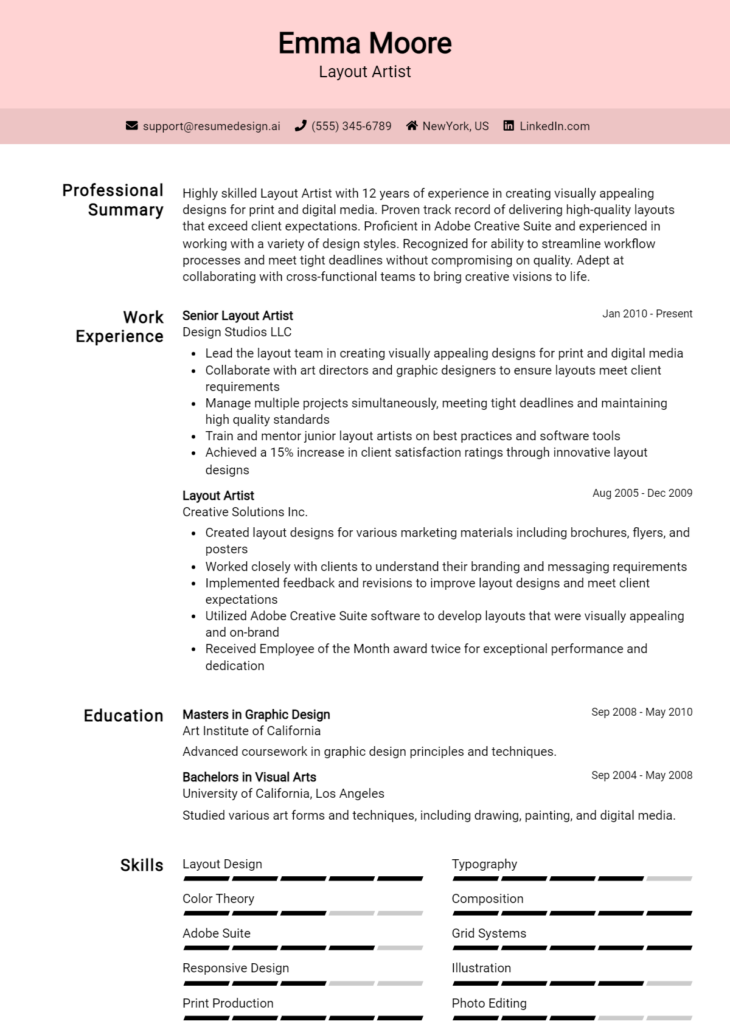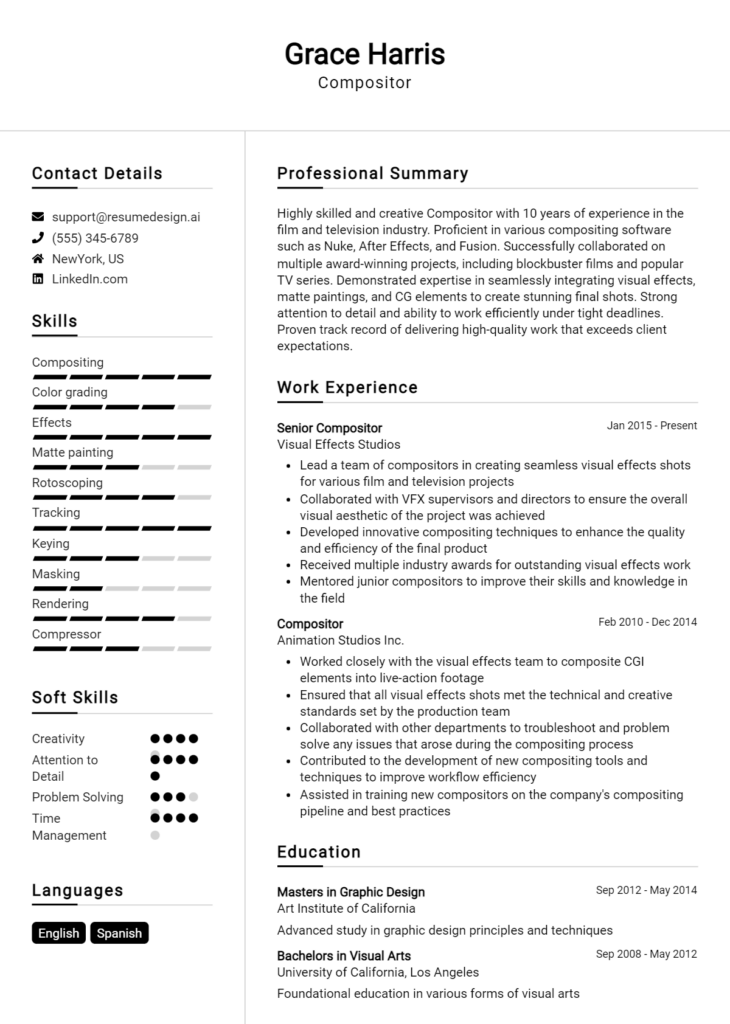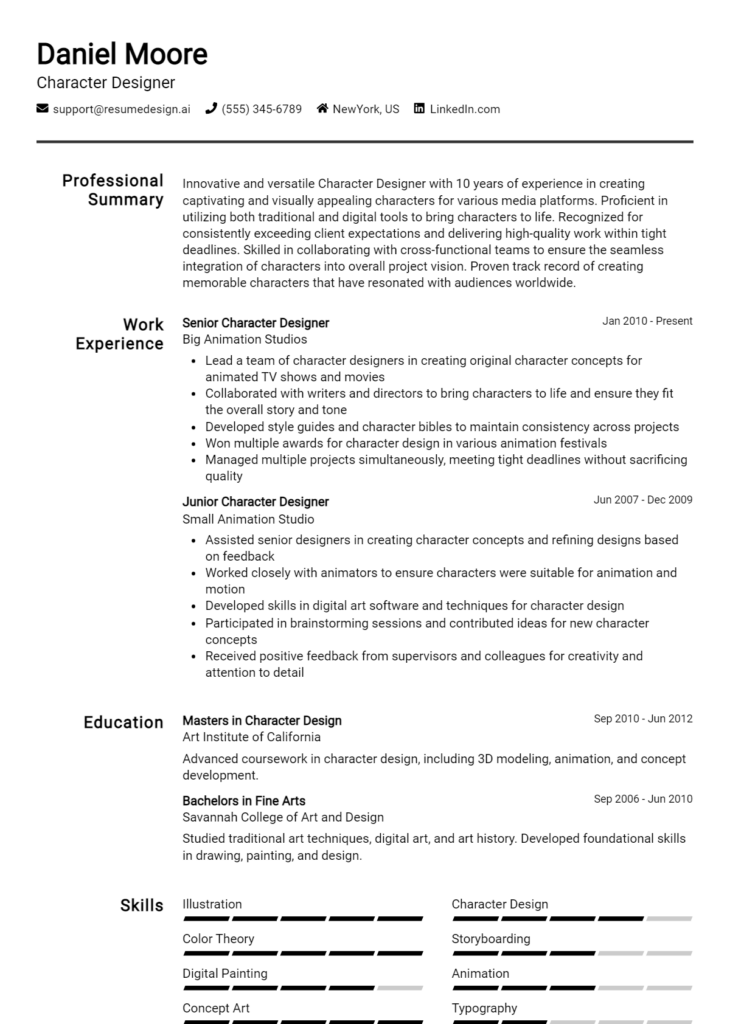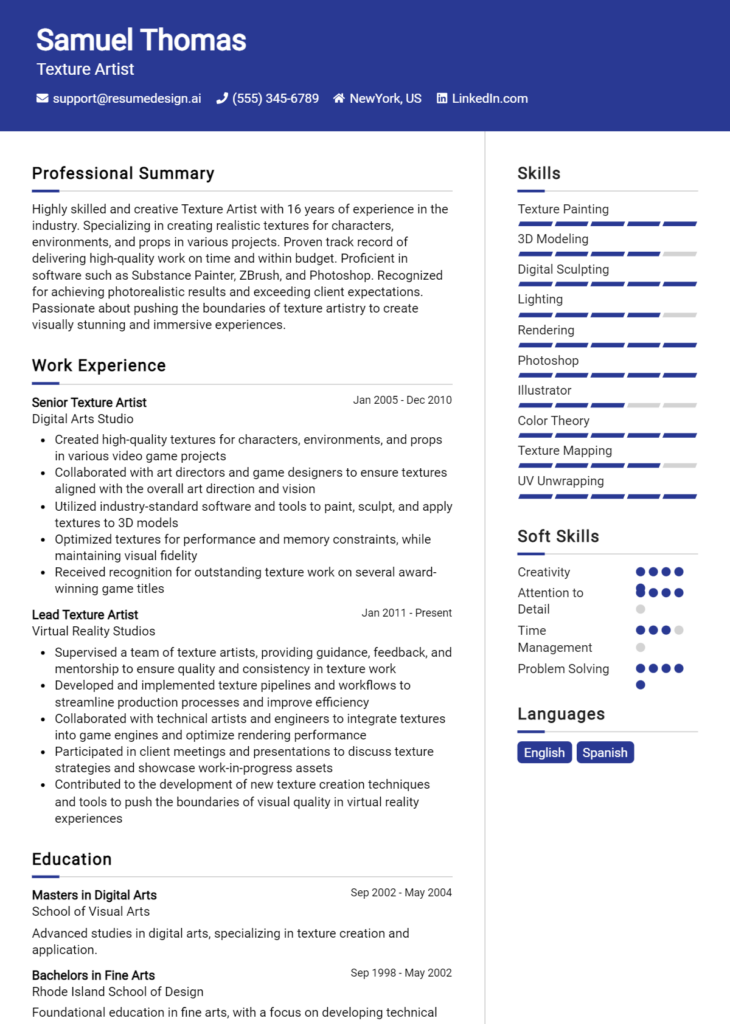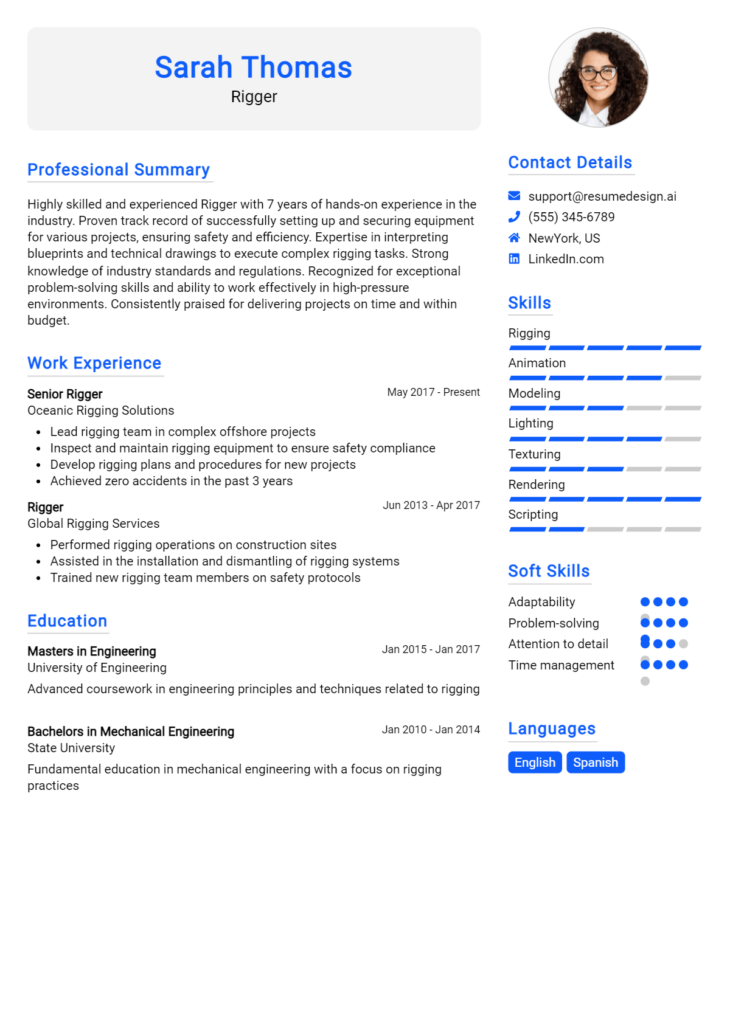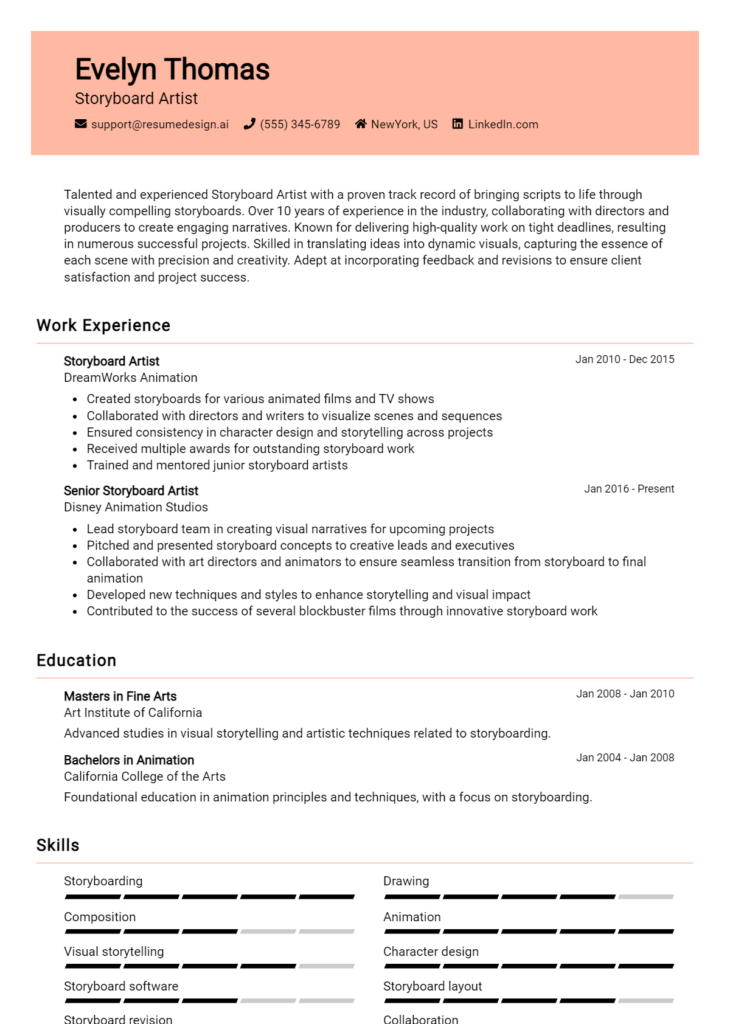Tracking Artist Core Responsibilities
A Tracking Artist plays a crucial role in the production pipeline, serving as the bridge between various departments such as animation, visual effects, and post-production. Key responsibilities include tracking and matching camera movements to ensure seamless integration of live-action footage with CGI elements. Essential skills include technical proficiency in tracking software, operational knowledge of production processes, and strong problem-solving abilities. These competencies contribute significantly to the organization's overall goals by ensuring visual coherence and enhancing storytelling. A well-structured resume highlighting these qualifications can effectively demonstrate a candidate's value to potential employers.
Common Responsibilities Listed on Tracking Artist Resume
- Utilize tracking software to achieve precise camera movement integration.
- Collaborate with directors and animators to understand project requirements.
- Analyze footage to identify tracking needs and challenges.
- Prepare tracking markers for optimal performance in various environments.
- Test and refine tracking data to ensure accuracy.
- Provide technical support during production and post-production phases.
- Communicate effectively with team members to address issues.
- Maintain organized documentation of tracking processes and revisions.
- Participate in review sessions to gather feedback and make adjustments.
- Stay updated on industry trends and advancements in tracking technology.
- Ensure compliance with project timelines and quality standards.
- Assist in training junior artists on tracking techniques and tools.
High-Level Resume Tips for Tracking Artist Professionals
In the competitive world of visual effects and animation, a well-crafted resume is crucial for Tracking Artist professionals looking to make their mark. As the first impression a potential employer will have of you, your resume needs to effectively showcase not just your skills, but also your achievements and contributions to past projects. It serves as a powerful marketing tool, demonstrating your ability to contribute to the team while aligning your experience with the specific needs of the job. This guide will provide practical and actionable resume tips tailored specifically for Tracking Artist professionals, ensuring you stand out in the crowded job market.
Top Resume Tips for Tracking Artist Professionals
- Tailor your resume to each job description by incorporating relevant keywords and phrases that align with the specific requirements of the position.
- Highlight your relevant experience in visual effects, emphasizing projects where your tracking skills made a significant impact.
- Quantify your achievements by including specific metrics, such as the number of shots completed or the efficiency improvements you implemented.
- Showcase your proficiency with industry-standard software such as Nuke, Mocha, or After Effects, ensuring these skills are easily identifiable.
- Include a dedicated section for your technical skills, listing relevant software, tools, and technologies that you are adept at using.
- Utilize a clean and professional layout that allows your skills and achievements to shine without unnecessary distractions.
- Incorporate links to your portfolio or demo reel to provide tangible evidence of your work and capabilities.
- Use action verbs to describe your contributions, making it clear how you added value to projects and teams.
- Keep your resume concise, ideally one page, focusing on the most relevant and impactful information.
- Proofread carefully to eliminate any errors, as attention to detail is critical in the visual effects industry.
By implementing these tips, Tracking Artist professionals can significantly increase their chances of landing a job in the field. A well-structured and tailored resume not only showcases your artistic talents but also demonstrates your understanding of the industry and your readiness to contribute effectively to future projects.
Why Resume Headlines & Titles are Important for Tracking Artist
In the competitive landscape of the film and animation industry, a Tracking Artist plays a crucial role in ensuring that visual elements seamlessly integrate with live-action footage or animated sequences. Crafting a compelling resume is essential for standing out, and the use of effective resume headlines and titles is a key component of this process. A strong headline or title can immediately capture the attention of hiring managers, providing a succinct summary of a candidate's key qualifications and unique value proposition in just a few words. It should be concise, relevant, and directly aligned with the job being applied for, serving as a powerful introduction that entices the reader to learn more about the candidate's skills and experience.
Best Practices for Crafting Resume Headlines for Tracking Artist
- Keep it concise: Aim for one impactful phrase that summarizes your qualifications.
- Make it role-specific: Tailor your headline to reflect the specific position you are applying for.
- Highlight key strengths: Focus on your most relevant skills and experiences.
- Use action words: Incorporate dynamic verbs to convey your capabilities and achievements.
- Be authentic: Ensure your headline reflects your true professional identity.
- Avoid jargon: Use clear language that can be easily understood by hiring managers.
- Include quantifiable achievements: Whenever possible, incorporate metrics that demonstrate your impact.
- Test for clarity: Ensure your headline is straightforward and conveys a clear message about your expertise.
Example Resume Headlines for Tracking Artist
Strong Resume Headlines
"Experienced Tracking Artist Specializing in Seamless Visual Effects Integration"
“Detail-Oriented Tracking Artist with 5+ Years in Film and Animation Production”
“Creative Tracking Artist with Expertise in Motion Capture and 3D Animation Techniques”
Weak Resume Headlines
“Artist Looking for Opportunities”
“Experienced Professional”
The strong headlines are effective because they provide a clear, specific, and relevant summary of the candidate's qualifications, immediately showcasing their skills and experience in a way that resonates with hiring managers. In contrast, the weak headlines fail to impress due to their vagueness and lack of specificity, leaving hiring managers with little insight into the candidate's actual expertise or fit for the Tracking Artist role. By avoiding generic statements, candidates can create a memorable first impression that encourages further exploration of their resume.
Writing an Exceptional Tracking Artist Resume Summary
A well-crafted resume summary is crucial for a Tracking Artist, as it serves as a powerful introduction that captures the attention of hiring managers. This concise section highlights key skills, relevant experiences, and notable accomplishments, allowing candidates to quickly convey their value in the competitive field of visual effects and animation. A strong summary is not only impactful but also tailored to the specific job being applied for, ensuring that it resonates with the employer's needs and expectations.
Best Practices for Writing a Tracking Artist Resume Summary
- Quantify Achievements: Use specific numbers or percentages to demonstrate the impact of your work.
- Focus on Relevant Skills: Highlight technical skills and software proficiencies that are essential for tracking artists.
- Tailor the Summary: Customize your resume summary for each job application, aligning it with the job description.
- Be Concise: Keep the summary brief, ideally between 3 to 5 sentences, to maintain the reader's interest.
- Use Action Verbs: Start sentences with strong action verbs to convey confidence and initiative.
- Showcase Industry Knowledge: Mention any relevant industry experience or familiarity with specific techniques or tools.
- Include Soft Skills: While technical skills are crucial, don’t forget to highlight collaboration, communication, and problem-solving abilities.
- Avoid Clichés: Steer clear of overused phrases that do not add value, focusing instead on unique contributions.
Example Tracking Artist Resume Summaries
Strong Resume Summaries
Dynamic Tracking Artist with over 5 years of experience in high-pressure environments, adept at utilizing Mocha and Nuke to deliver seamless visual effects. Successfully tracked over 200 shots for feature films, achieving a 98% accuracy rate and consistently meeting tight deadlines.
Detail-oriented Tracking Artist skilled in 3D tracking and rotoscoping with a proven track record of improving workflow efficiency by 30%. Contributed to award-winning projects, recognized for innovative problem-solving and collaboration within multidisciplinary teams.
Results-driven Tracking Artist with advanced expertise in camera tracking and match moving, having worked on projects that garnered three industry awards. Known for delivering high-quality results under tight deadlines, with a commitment to continuous learning and adaptation to new technologies.
Weak Resume Summaries
Experienced artist looking for opportunities in tracking and visual effects. I have worked on various projects and have some skills in software.
Motivated professional with a background in visual effects. I’m eager to bring my skills to a new position and help create amazing visuals.
The examples of strong resume summaries are considered effective because they provide specific details about the candidate's experience, quantifiable results, and relevant skills that directly relate to the Tracking Artist role. In contrast, the weak summaries lack specificity, do not quantify achievements, and fail to convey a clear sense of competence or relevance to the position, making them less appealing to hiring managers.
Work Experience Section for Tracking Artist Resume
The work experience section of a Tracking Artist resume is pivotal in demonstrating a candidate's proficiency in technical skills, their capability to manage collaborative projects, and their commitment to delivering high-quality visual outputs. This section not only highlights previous roles and responsibilities but also emphasizes quantifiable achievements that align with industry standards. By showcasing specific contributions and results, candidates can effectively illustrate their expertise and value to potential employers, making it crucial to present this information in a clear and impactful manner.
Best Practices for Tracking Artist Work Experience
- Focus on technical skills relevant to tracking, such as proficiency in software like Nuke, Mocha, or After Effects.
- Quantify achievements by including metrics such as project completion time, budget adherence, and client satisfaction ratings.
- Highlight collaborative efforts, detailing how you worked with other artists, directors, and technical teams.
- Use action verbs to describe your responsibilities and achievements, making your contributions sound proactive and impactful.
- Tailor your experience to match the job description, using keywords that align with industry standards.
- Include specific examples of challenges faced and how you overcame them, showcasing problem-solving skills.
- Demonstrate leadership by mentioning any mentoring or training roles undertaken.
- Keep descriptions concise and focused, avoiding unnecessary jargon while remaining industry-relevant.
Example Work Experiences for Tracking Artist
Strong Experiences
- Led a team of 5 artists on a high-profile feature film, successfully reducing tracking errors by 30% through streamlined workflows and enhanced communication.
- Implemented a new tracking system that improved project turnaround time by 25%, resulting in a 15% increase in client satisfaction ratings.
- Collaborated with visual effects supervisors on over 10 projects, ensuring seamless integration of live-action and CGI elements, which contributed to a 40% increase in overall project efficiency.
- Trained junior artists in advanced tracking techniques, enhancing team skills and resulting in a 20% improvement in project quality metrics.
Weak Experiences
- Worked on various projects as a tracking artist, contributing to the overall success of the team.
- Participated in meetings to discuss project progress and issues.
- Assisted in tracking tasks and helped others when needed.
- Performed general tracking duties on multiple projects without specific outcomes or contributions noted.
The examples listed above demonstrate a clear distinction between strong and weak experiences. Strong experiences are characterized by specific, quantifiable outcomes and highlight the candidate's leadership and collaborative efforts, showcasing their value to prospective employers. In contrast, weak experiences lack detail and fail to provide measurable impacts, making it difficult for hiring managers to gauge the candidate's true capabilities and contributions.
Education and Certifications Section for Tracking Artist Resume
The education and certifications section in a Tracking Artist resume plays a pivotal role in showcasing a candidate's academic background and professional qualifications. This section not only reflects the candidate's commitment to their craft but also highlights their adherence to industry standards through relevant certifications and continuous learning efforts. By providing details on relevant coursework, certifications, and any specialized training, applicants can significantly enhance their credibility and demonstrate their alignment with the specific demands of the Tracking Artist role, making them more appealing to potential employers.
Best Practices for Tracking Artist Education and Certifications
- Prioritize relevant degrees in fields such as film, animation, or visual effects.
- Include industry-recognized certifications from reputable organizations or software providers.
- Detail any specialized training programs that focus on tracking or motion capture technologies.
- Highlight coursework that is directly applicable to tracking and visual effects, such as 3D animation or digital compositing.
- Keep descriptions concise but informative, focusing on skills gained and knowledge acquired.
- Regularly update this section to reflect new qualifications or advancements in the field.
- Use a clear format that allows hiring managers to quickly assess qualifications at a glance.
- Consider including any workshops or seminars attended that are pertinent to tracking artistry.
Example Education and Certifications for Tracking Artist
Strong Examples
- Bachelor of Arts in Visual Effects, University of Southern California
- Certified Motion Capture Specialist, International Society of Motion Capture
- Coursework in 3D Animation and Motion Tracking Techniques, Animation Mentor
- Advanced Tracking Techniques Workshop, The Motion Capture Academy
Weak Examples
- Bachelor of Arts in History, Local State University
- Certification in Basic Computer Skills, Online Learning Platform
- Coursework in English Literature, Community College
- Outdated Motion Graphics Certification from 2005
The strong examples listed above are considered effective because they are directly relevant to the Tracking Artist role, showcasing degrees and certifications that reflect industry standards and specialized skills. In contrast, the weak examples lack relevance to the position, highlighting degrees and certifications that do not align with the core competencies needed for a Tracking Artist, which could lead hiring managers to question the candidate's suitability for the role.
Top Skills & Keywords for Tracking Artist Resume
As a Tracking Artist, showcasing the right combination of skills on your resume is crucial to capturing the attention of potential employers. This role requires a unique blend of technical expertise and creative finesse, making it essential to highlight both hard and soft skills effectively. A well-crafted resume not only outlines your qualifications but also reflects your adaptability, problem-solving abilities, and teamwork orientation. By emphasizing your skills, you can demonstrate your readiness to contribute to a project and collaborate with fellow artists, enhancing your chances of standing out in a competitive job market. For more insights on how to effectively present your qualifications, check out our resources on skills and work experience.
Top Hard & Soft Skills for Tracking Artist
Soft Skills
- Attention to Detail
- Strong Communication
- Team Collaboration
- Time Management
- Problem-Solving
- Adaptability
- Creative Thinking
- Critical Feedback Reception
- Organizational Skills
- Initiative
Hard Skills
- Proficiency in Tracking Software (e.g., Mocha, Nuke)
- Understanding of 3D Motion Tracking
- Compositing Techniques
- Familiarity with Visual Effects (VFX) Principles
- Color Grading Knowledge
- Experience with Camera Tracking
- Knowledge of Matchmoving
- Familiarity with CGI Integration
- Proficiency in Editing Software (e.g., Adobe Premiere, After Effects)
- Understanding of 2D and 3D Animation Principles
Stand Out with a Winning Tracking Artist Cover Letter
Dear [Hiring Manager's Name],
I am writing to express my enthusiasm for the Tracking Artist position at [Company Name] as advertised on [Job Board/Company Website]. With a robust background in visual effects and a passion for creating seamless animations, I am excited about the opportunity to contribute to your team. My experience in tracking and match-moving, combined with my proficiency in industry-standard software, makes me a strong candidate for this role.
In my previous position at [Previous Company Name], I successfully executed complex tracking tasks for various projects, including commercials and feature films. My attention to detail and ability to analyze footage allowed me to achieve precise camera tracking and stabilize shots effectively. Collaborating closely with the VFX team, I was able to translate creative visions into accurate and compelling visual narratives. I take pride in my ability to adapt to different styles and requirements, ensuring that the final product meets both artistic and technical standards.
Moreover, I am proficient in using software such as Adobe After Effects, Nuke, and Mocha, which have equipped me with the tools necessary to tackle challenging tracking scenarios. My commitment to continuous learning keeps me updated on emerging technologies and techniques in the VFX industry, allowing me to bring innovative solutions to the projects I work on. I thrive in fast-paced environments and enjoy collaborating with diverse teams to achieve exceptional results.
I am excited about the possibility of joining [Company Name] and contributing my skills to help elevate your projects. Thank you for considering my application. I look forward to the opportunity to discuss how my expertise can benefit your team.
Sincerely,
[Your Name]
[Your Phone Number]
[Your Email Address]
Common Mistakes to Avoid in a Tracking Artist Resume
When crafting a resume for a Tracking Artist position, it's essential to present your skills and experience in a clear and compelling manner. However, many applicants make common mistakes that can undermine their chances of landing an interview. By avoiding these pitfalls, you can enhance your resume's effectiveness and showcase your qualifications more effectively. Here are some common mistakes to be aware of:
Neglecting to Tailor Your Resume: Failing to customize your resume for the specific job can make it seem generic. Highlight relevant experience and skills that align with the job description.
Overloading with Technical Jargon: While technical skills are vital, using too much jargon can alienate hiring managers. Ensure that your language is accessible and that you explain complex terms where necessary.
Ignoring Visual Presentation: A cluttered or poorly formatted resume can be off-putting. Use a clean layout and consistent fonts and spacing to make your resume visually appealing.
Omitting Key Software Proficiencies: Tracking Artists often need to be familiar with specific software. Make sure to include any relevant software skills prominently in your resume.
Listing Responsibilities Instead of Achievements: Simply listing job duties doesn’t showcase your impact. Focus on quantifiable achievements and how your contributions benefited previous projects.
Failing to Include a Demo Reel Link: In creative fields, a demo reel is often more informative than a written resume. Ensure to include a link to your demo reel or portfolio for easy access.
Not Proofreading for Errors: Typos and grammatical mistakes can create a negative impression. Always proofread your resume multiple times, or ask someone else to review it for you.
Using a One-Size-Fits-All Approach: Each position may require different skills or experiences. Avoid using the same resume for every application; tailor it to reflect what the specific employer is looking for.
Conclusion
As a Tracking Artist, your role is pivotal in ensuring that visual effects integrate seamlessly into the live-action footage. Throughout the article, we explored the essential skills and qualifications necessary for this position, including proficiency in software like Nuke and Maya, strong attention to detail, and effective communication skills. We also discussed the importance of collaboration with directors, cinematographers, and other artists to achieve the desired visual outcome.
To stand out in a competitive job market, it's crucial to present a polished resume that highlights your unique experiences and skill set. Take the time to review and refine your Tracking Artist resume to make a lasting impression on potential employers.
If you’re looking for resources to enhance your resume, consider utilizing resume templates, which can help you create a visually appealing document. Alternatively, you can use the resume builder for a more guided approach. Don’t forget to check out resume examples for inspiration and ensure your resume aligns with industry standards. Additionally, a compelling cover letter can set you apart, so explore our cover letter templates to craft a narrative that showcases your passion and qualifications.
Take action today and invest in your career by updating your resume and cover letter. Your next opportunity as a Tracking Artist is just around the corner!

